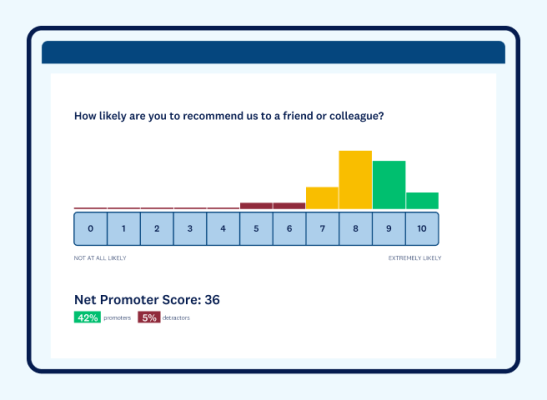How to turn NPS detractors into promoters

Customers have more options than ever before when buying products and services. Businesses have to satisfy those customers across every touchpoint to stay competitive—that includes understanding why some customers are unhappy, assisting them with their problems, and actively seeking feedback to continuously improve the customer experience (CX).
Of all the metrics used to understand customer satisfaction and experience, Net Promoter Score® (NPS) is one of the most widely adopted and effective. NPS measures how likely customers are to recommend a company's products or services to others, providing a clear indicator of customer loyalty and satisfaction.
This simple yet powerful metric allows businesses to quantify customer sentiment, identify areas for improvement, and track progress over time. Measuring and improving NPS can strengthen customer relationships and boost your company’s reputation.
NPS detractors vs. promoters
What are NPS detractors?
In the context of NPS, detractors are customers who answer between one and six to your NPS survey. These individuals are usually unhappy with your services and would be unlikely to recommend your company to others. Additionally, they could publicly voice their negative perception of your brand, damaging your reputation.
NPS detractors will have typically had a negative experience with your business. They may have had one of the following experiences with your business:
- Customer support left a customer issue unsolved
- Your products or services didn’t live up to the customer’s expectations
- They experienced delivery or service delays
- Your business was inconsistent across customer touch points
- They found better alternatives from your competition
Understanding the common reasons why customers become detractors is important if you want to improve overall customer satisfaction. According to SurveyMonkey research, 89% of customer experience pros say CX is a leading contributor to churn. Given this strong link between CX and customer retention, it's vital for businesses to enhance every aspect of the customer journey.
What are NPS promoters?
Promoters are your most satisfied customers, scoring your business a 9 or 10 on the NPS survey. These customers are not just content; they're enthusiastic about your company, products, and services. Their high level of satisfaction makes them likely to recommend your business to friends, family, and colleagues. As a result, promoters often become valuable ambassadors for your brand, effectively serving as a powerful form of word-of-mouth marketing.
NPS promoters can respond favorably to your business for several reasons:
- Your customer success team provided an exceptional level of service
- Your products and services exceeded their expectations
- You were reliable and accessible across every stage of the customer journey
- You engaged positively with customers and made them feel special
Promoters can become some of your biggest supporters and will likely repeatedly buy or engage with your business. Knowing what makes someone a promoter is useful for intentionally improving customer relationships.
How to calculate Net Promoter Score
The Net Promoter Score survey is a simple way of determining customer health. You can gather all the information you need by asking one question: “How likely are you to recommend us to a friend or colleague?”
Customers will respond to this question on a scale of 1-10. An answer of one means they are not at all likely to recommend your business. Contrastingly, an answer of 10 suggests they are extremely likely to recommend your products and services.

To calculate your NPS, you’ll need to use the following equation: Percent promoters – percent detractors = NPS.
The NPS calculation will give you a number ranging from -100 to 100. If your customers were all promoters, you would score 100, while the opposite is true for detractors.
A good NPS score is hard to pin down to one figure. We’ve published SurveyMonkey NPS Benchmarks, which suggest a good NPS score for certain industries. That said, above 50 is great, and above 70 is impressive. If you want a helping hand, we offer an NPS calculator to cut the work for you.
How to improve NPS in 8 steps
Improving your customer relationships will help to turn any detractor into a shining example of a promoter. With more promoters for your business, your brand reputation will improve. You’ll also experience increased customer satisfaction, brand loyalty, and company growth.
Below are eight methods your business can use to improve your NPS.
1. Establish benchmarks
After calculating your NPS for the first time, you will better understand your business's total number of promoters, passives, and detractors. This initial measurement serves as your baseline, allowing you to set realistic improvement goals.
The next step is to determine a specific target for your future NPS. Thanks to its numerical nature, NPS provides an easily trackable benchmark. You might choose to focus on raising your overall score or reducing the number of detractors.
Either approach will enhance customer satisfaction and strengthen your relationships with clients. With a well-defined goal in place, you can begin implementing strategies to improve your NPS.
2. Uncover detractors’ pain points
Another valuable part of the NPS survey that you can add is a second, optional follow-up question. These secondary questions provide and opportunity for open-ended customer feedback, so that detractors can explain why they feel the way they do. After collecting NPS survey feedback, you may notice a commonly occurring complaint. From there, you can improve that area and help to improve people’s interaction with your brand.
Identifying and resolving these pain points is indeed a powerful strategy for improving customer relationships and elevating your NPS. Moreover, this process creates a continuous feedback loop, allowing for ongoing refinement of your products, services, and customer interactions.
3. Understand what creates brand promoters
Gathering customer feedback from your brand promoters is a valuable tool for gaining deeper insights into your customers' preferences. Through the optional open-ended NPS question, satisfied customers can articulate the specific reasons behind their positive ratings.
These responses highlight your company's strengths and best practices. For instance, promoters might consistently praise your quick and efficient customer service team or the superior quality of your products.
4. Personalized follow-up
When someone responds negatively to your NPS survey, they will likely feel your business doesn’t take them seriously. Exceed their expectations by keeping the conversation going—this is how you can change an NPS detractor into a promoter, while showing you care.
Taking a personalized approach can be very impactful. In fact, according to SurveyMonkey research, 72% of consumers say personalization is important when thinking about brands they like.
Reaching out to a detractor with a personalized follow-up is a winning strategy to improve their perception of your brand. You can highlight their concern and demonstrate how to improve the problem. Always include actionable strategies that you will use to remedy their issue.
Sometimes, just showing a customer their voice is essential to your business is all it takes to win a new promoter. Learn more strategies to put the voice of the customer at the forefront of your business operations.
5. Build loyalty and advocacy programs
At its core, a good NPS score reflects your customers’ loyalty to your brand. High NPS scores translate to businesses with a large base of loyal customers. Offering loyalty programs and incentives can effectively increase the number of promoters your business has.
Loyalty programs allow customers to benefit more from repeatedly purchasing from your business. Equally, offering special promotions to return customers will make them feel appreciated. By focusing on rewarding loyalty, you will show your customers that your business genuinely cares about their support.
Building these programs can help to forge stronger customer relationships. When it comes time to fill out an NPS survey, these loyal customers will reflect their gratitude with higher scores.
6. Continuously measure progress and gather customer feedback
As a metric that reflects customer satisfaction, it’s important to track your NPS score continuously. Over time, changes in your NPS will reflect the impact of your efforts. If you’re noticing an increase in promoters, your adaptations work.
Regularly tracking your NPS will also allow you to see if the number of detractors is increasing. Pinpointing an increase in detractors and the reasons behind this change will help you to fix any new problems in your customer journey.
Continuously measuring NPS progress ensures you stay up to date with how your customers feel. You can combine NPS surveys with CSAT and CES surveys to more accurately trace the customer experience and follow evolving customer sentiments.
For more information, read our ultimate guide to running a customer feedback program.
7. Build a customer-centric culture
Developing a customer-centric culture means prioritizing customer experience as a core value throughout your entire organization. Improving your customer relationships impacts almost every area of your business.
Here are just a few of the many benefits to improving your NPS score:
- Higher rates of customer satisfaction
- Less customer churn and increased retention
- Boosted sales
- Increased customer lifetime value (LTV)
Try to understand your NPS detractors and their common pain points. You can create a customer-first culture filled with positive experiences by improving upon them. Alongside NPS, you can calculate the overall Customer Satisfaction Score (CSAT) to discover what your customers think of your company.
8. Provide ongoing employee training programs
One primary way to improve a customer’s experience with your business is through better training your employees. Your team represents your company and has the power to make a great impression on your customers. Employee training is vital, especially for customer experience and customer success departments.
If your NPS detractors often comment on poor experiences with your employees, training should be your first port of call.
Turn your detractors into promoters with SurveyMonkey
Turning NPS detractors into promoters isn’t only about boosting your NPS score. On the contrary, it’s about building a better customer journey by implementing a customer-centric approach.
Possessing the willingness to adapt to customer expectations and demands allows you to forge lasting customer relationships. NPS surveys and the information they offer are a phenomenal way of understanding your customers.
While creating better customer experiences won’t happen overnight, it’s one of the best changes your business can make. With SurveyMonkey, you can easily create custom NPS surveys that allow your customers to make their voices heard.
NPS, Net Promoter & Net Promoter Score are registered trademarks of Satmetrix Systems, Inc., Bain & Company and Fred Reichheld.
Discover more resources

Customer satisfaction survey templates
Explore our customer satisfaction survey templates to rapidly collect data, identify pain points, and improve your customer experience.

How industry leaders use employee and customer feedback to drive innovation
How to use customer and employee feedback to drive innovation with insights from LinkedIn, FranklinCovey, and Hornblower.

2024 holiday insights and shopping trends: 100+ key stats
Only 12% of consumers plan to increase their holiday budgets in 2024. Discover 100+ stats and tips for business leaders to drive sales this season.

How Wave Deodorant launched its company with market research
Discover how Wave Deodorant validated product development and launched its company with market research insights from SurveyMonkey.